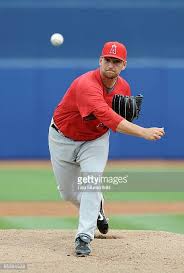Shane Loux: Former RHP Tigers/Angels/Giants
1. Could you tell us your story on dropping down?
When I was drafted out of high school I was an over the top, 4-seam fastball and 12-6 curveball guy that threw in the mid 90s. I rode that for about 5 years. After an elbow scope and rehab, I lost flexibility and lost range of motion. Along with the elbow stuff, my shoulder started bothering me and so I found a more comfortable slot down into a lower 3/4. When I started throwing from there, I found some sink and run on the ball and stayed there for the rest of my career.
2. What are some of the advantages you have from your arm angle?
I found the sink and committed myself to dominate the arm side of the plate. Over time I also learned to manipulate the ball from there as well as cut it. It made me an effective starter because I could get early weak contact and pitch deep into games. It also gave me the opportunity to pitch in the big leagues as a long relief guy for 5 years.
3. If you didn't drop down, do you think you would have had the same success?
I think I would have still had some success because of my ability to adapt and constantly make changes to keep up with the hitters that changed. It was a difficult transition my first year at a lower angle, but then I embraced it and starting having success again. I am glad things went the way it did because it allowed me to see that I can make big changes and still compete.
4. What would you tell someone debating on changing their arm angle?
I would immediately question their motives. Why? I changed because I had to, not because I thought it would be cool or anything like that. I like the stories of guys that are at the end of their road and then decide to make big changes to try to resurrect their career. Those guys have the will and motivation to put in the work that it is going to take to get the job done.
5. Are there any mechanical tips that you'd give to someone throwing sidearm/submarine?
I believe that if you are going to make this kind of change, you have to be comfortable. Choose a slot that's most comfortable to you, don't let anyone tell you where you should be. Find a slot you can comfortably throw strikes from and go from there.
6. What pitches do you throw?
After I dropped down a little, I primarily threw sinkers. As I got older I was able to mix speeds with it as well. I would be anywhere between 83-93 throughout the game. I also threw a changeup and curveball from there. The CB was an odd thing that required constant work and refining because that arm angle is so difficult to get the CB spin I needed. I kept with it because it was such a different look from the sinker arm slot. Over time, I was also able to perfect a 4 seam FB to my glove side to keep LHHs off the sinker away.
7. How do you pitch to lefties/righties?
I was relentless inside to RHHs. I never gave in and never went away with FBs. If they were on my FB, I went farther in or took something off it. To LHHs, I worked arm side, but was also able to throw up and in at their hands when I needed to. It helped open up both sides of the plate for outs.
8. What is your favorite part about pitching from down there?
I believe that having to drop down a little bit was a blessing because it allowed me to develop a sinker which turned into a major league pitch and allowed me to pitch professionally for almost 20 years. Not sure that would have happened if I would have stayed over the top. It kept me from becoming just an average RHP who fizzled out after a few years.





